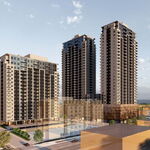CITY PARKS
'Magic' of Downsview coming to life
But critics fear original promise of 'unique urban recreational green space' is disappearing before their eyes
JENNIFER LEWINGTON
April 13, 2009
CITY HALL BUREAU CHIEF
http://www.theglobeandmail.com/serv...OWNSVIEW13ART2255/TPStory/TPNational/Ontario/
Hidden from view behind the hoardings on Keele Street in the city's northwest, Downsview Park is coming to life.
With little fanfare, the federal agency responsible for the long-hyped "national urban park" plans to spend $17-million this year, triple the budget in 2008.
Excavation is under way on a 3.6-hectare pond for storm water runoff. To be completed by 2010, the pond will double as a venue for paddle boats and canoes in summer and skaters in winter. A Canadian-Football-League-size sports field is set to open this fall. And, with urban agriculture in vogue, the park is installing several greenhouses, along with garden plots (for a fee), this summer.
"It is the beginnings of creating the magic of the park," Downsview Park chairman David Soknacki said. "Because the park has been so overannounced, what we have decided to do is 'just do it.' "
But to many local residents, there is little joy in the transformation.
That's because of the controversy over how much private housing development will be needed at the park to pay for $100-million in improvements by 2015.
Now that construction of the Spadina subway extension is in its early phase - with a station at the northern tip of Downsview - and a city planning blueprint for the area near completion, the battle lines are hardening again.
"Don't be fooled by what you are looking at," said Michael Calabrese, executive secretary of the Downsview Lands Community Voice Association, a 350-member residents group. The organization is concerned that the original promise of a "unique urban recreational green space" is disappearing before their eyes.
"Most of [us] firmly believed Jean Chrétien when he said the land would be held in perpetuity to be used as a park for future generations," Mr. Calabrese said. In 1994, the then-prime-minister pledged to hand over the onetime military base for parkland that would rival Toronto's High Park.
"The residents of the area were under the assumption that all 572 acres were going to be used for green space," he added, insisting, "That is not the case any more."
Whether that was ever the case is a matter of dispute.
Downsview's official federal mandate is to bring the park to life with revenue from the lease or sale of some of its lands to private developers, and not by using taxpayer dollars.
"We feel very strongly that our interest is the public interest," said Mr. Soknacki, the former city budget chief. He was appointed chairman of Downsview Park in 2007 after retiring from politics. "Our goal is to maximize the amount we can put into programming green space and park."
The challenge for city planners, due to report back to residents next month, is figuring out the right mix of parkland, housing, recreational facilities and industry for the 526-hectare precinct that includes the park and Bombardier Aerospace de Havilland.
The so-called "secondary plan," replacing one approved by council in 1999, would revamp the boundaries of the park and intensify housing close to the new subway at Sheppard West. The revised plan will likely go to North York Community Council, and later to city council, this fall.
Mr. Soknacki said that 7,500 housing units on the site is "appropriate." He added that "more units will allow us to create the park faster. Less will be challenging."
That still leaves 148 hectares for green space, he said, with 121 hectares of core parkland.
But Mr. Calabrese and the city councillors whose wards envelope or abut the park remain skeptical. He argues that an influx of new residents would burden existing services and add to traffic congestion. "We fear it might become another community struggling with low-income problems."
The three local councillors have their own objections.
Councillor Michael Feldman (Ward 10, York Centre) is unhappy at the lack of green space and sports fields for his constituents on the eastern edge.
"It seems like all the good stuff, the lollipops, are going to the west side of the [Bombardier] runway, and we get nothing on the east side other than more residential," he said.
Councillor Anthony Perruzza (Ward 8, York West), whose ward includes the new transit stop, said that will bring higher-density housing than set under the 1999 plan.
Councillor Maria Augimeri (Ward 9, York Centre), with most of the park and some low-rise housing likely to come in her ward, sides with residents. "I don't support the intensification," she said. "It is just too much for the community."
Navigating the troubled waters is Mr. Soknacki, widely praised for his diplomacy. Downsview gave $10,000 to the neighbourhood hit by last year's propane explosion and put up almost $1-million for the revised secondary plan.
"We will move heaven and earth to provide a result that works for everyone," he said.
As Mr. Calabrese and his neighbours prepare for the next consultations in May, he said the mood is resolute. "We live here," he said. "That is what keeps us going - and the four-letter word is 'live.' "





